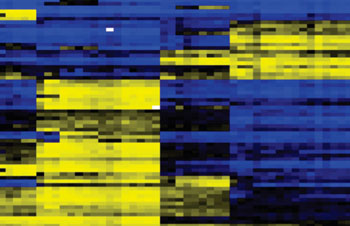Quantization of Leukocyte Subsets with DNA Methylation Microarrays
By LabMedica International staff writers
Posted on 20 Mar 2014
A novel microarray-based technique uses DNA methylation to simultaneously quantify multiple leukocyte subsets, enabling the investigation of immune modulations in both fresh blood samples and archived samples that previously could not be used for such analysis.Posted on 20 Mar 2014
Cell lineage-specific DNA methylation patterns distinguish normal human leukocyte subsets and can be used to detect and quantify these subsets in peripheral blood. However, all the current methods for counting immune cells in a blood sample require whole cells, with the "gold standard" methods being: manual five-part differential count, CBC (complete blood count) with automated five-part differential and fluorescence-activated cell sorting (FACS).

Image: A new technique distinguishes cell types in blood by looking at signature degrees of methylation in DNA. Yellow represents no methylation, blue full methylation (Photo courtesy of Brown University).
Investigators at Brown University (Providence, Rhode Island, USA) have developed an approach using DNA methylation to simultaneously quantify multiple leukocyte subsets without the need for counting whole cells.
They used the Illumina (San Diego, CA, USA) Infinium HumanMethylation and VeraCode GoldenGate Methylation microarray assays to identify cell lineage-specific DNA methylation signatures that distinguished among human T-cells, B-cells, NK cells, monocytes, eosinophils, basophils and neutrophils. They then employed a bioinformatics-based approach to quantify these cell types in complex mixtures, including whole blood, using DNA methylation signatures at as few as 20 CpG (cytosine and the guanine connected by a phosphodiester bond) loci.
Applying this DNA methylation-based approach to quantify the cellular components in 80 human whole blood samples, they verified its accuracy by direct comparison to gold standard immune quantification methods that utilized physical, optical, and proteomic characteristics of the cells. They also demonstrated that the approach was not affected by storage of blood samples, even under conditions prohibiting the use of gold standard methods.
“Every kind of cell has its own methylation signature,” said senior author Dr. Karl T. Kelsey, professor of epidemiology at Brown University. “Once you understand the unique and really immutable signature that directs the differentiation of the cell, then you can use that and you do not need the cell anymore.”
The study was published in the March 5, 2014, online edition of the journal Genome Biology.
Related Links:
Brown University
Illumina














